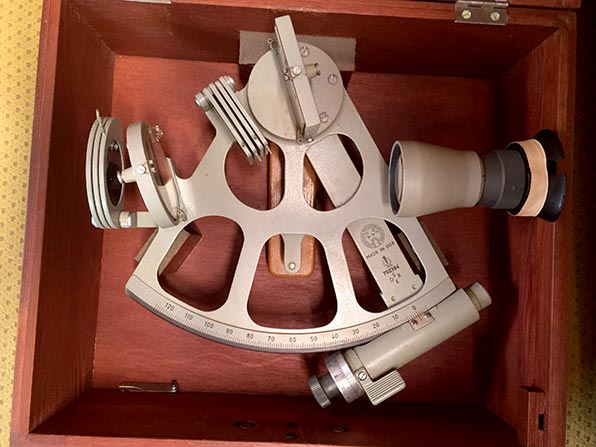Going old school
You may have heard that with increased concern of cyber security, the US Naval Academy has resumed offering instruction in Celestial Navigation, something that it hasn’t done in 20 years. This is a subject that has long been of interest to me. I was given a sextant by our friend Pete, then Captain of the schooner Coral. We also found a very nice one on board Frost. The problem is, I’ve never had any real instruction in how to use them.

This nice sextant came with our new boat.
During a break in one of this week’s squalls, on a rare moment when the sun presented itself, I broke out both sextants and played around with getting a sun sight. Of course, that’s only the first step in using the sextant to determine position. Later today I’m hoping to get together with Gavin, one of our cruising buddies, who has kindly offered to show me the basics. I think it’ll be a while before I’m up to the level of the guys in the book that I mentioned yesterday, My Old Man and the Sea, who used only a sextant to pilot their boat all the way around Cape Horn. Impressive!

The only reason I was even able to begin to get the sun sight the other day is because of
the mini lesson I received from our cruising friend Eric back in 2013.


Hi, you may find this link useful… http://www.scribd.com/doc/24854738/Sextant-step-by-Step
Rgs,
Garry
As we prepare for our departure, I too thought knowing celestial navigation would be advantageous, especially since I’ve been a lifelong astronomy buff. My reasoning was that celestial nav could be important in case of an electrical failure that left our onboard electronics (GPS, computers, etc) non-functional. I dropped out of the class halfway through when I learned how laborious the calculations were for anything beyond a simple noon sun sight. There were so many calculations necessary, and so many ways to screw them up, that I realized you’d have to practice it every day to have any hope of being able to do a sight reduction in an emergency. It’s not something you can just learn and then go back to in six months or a year. The best way to do the sight reductions is with a computer, but that sort of defeats the purpose of learning to navigate without electronics. So I used the money I would have spent on a sextant to buy an additional hand held (battery powered) GPS instead. It’s in the ditch bag.
Robert & Rhonda
S/V Eagle Too
Pensacola, FL
http://www.LifeOnTheHook.com
Blast from the past! Just learn the noon site, that’s good enough for emergencies. You can always stand off until it gets light to enter an unknown harbor (which we do anyway)
Don’t be intimidated by the calculations.
Eric from Sarana has a good description here:
http://www.svsarana.com/Nav_Info/noonsite.php
Eric
I think celestial navigation is great fun, even if it does make me cuss a bit!
🙂
I’ve always wanted a traverse board, even though I have no earthly used for one. During a school field trip, back when my daughter was young, a guide at James Town explained their use. Cool in their simplicity. I’ll have to make one someday and use it on a trip, just for fun.
http://historyencounters.weebly.com/uploads/4/6/8/7/46878537/9096953_orig.jpg
http://historyencounters.weebly.com/traverse-board.html
Interesting. I’ve never heard of that before.
Mike, this little book will get you started.
http://www.amazon.com/Celestial-Navigation-Yachtsmen-Mary-Blewitt/dp/0070059284
Quote from SV Totem’s website:
Celestial – it is very, very ironic but we use an app to turn a sextant sights into a lat/long position. Yes. I know. But hey- it means still getting in practice with the sextant, right?
http://www.sailingtotem.com/2015/07/the-best-apps-for-cruising.html
🙂
Yes, there are numerous (relatively expensive) iPhone apps that can do the hard math for you. That kind of defeats the purpose though. I think I’ll force myself to do it all long hand first before allowing myself to “cheat.” 🙂
I taught myself celestial nav a few years ago, just for the fun of it. And it is kinda sorta fun. And relatively easy to do all the calculations from the comfort of my land-based desk!
But here are some realities: Even with lots and lots and lots of practice, it still takes a the good part of an HOUR to do a fix from start to end using about three celestial sites. And that was with an electronics device (in my case, a hand-held programmable calculator) to do the Sight Reduction number crunching. If I had to look up the Sight Reduction numbers in the HO books, it would take even longer. Either way, there are an infinite number of opportunities to make a mistake.
And on a boat, at sea, down at the nav station while pitching and rocking & rolling over the waves, probably fighting exhaustion and seasickness? Yikes!! It sure gives me great admiration for our pre-GPS sailing ancestors, tho.
When quick and accurate nav at sea is needed, I’ll take my chances with the GPS satellite system going down.
What else do you have to do on a long ocean passage? Largely nothing!